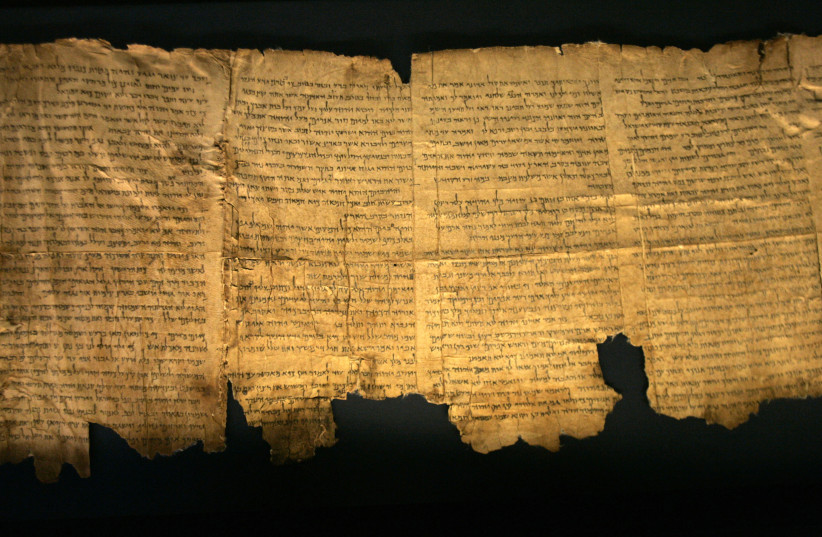German-Israeli project to bring the Dead Sea Scrolls alive on the screen
Source: Jerusalem Post, 5-20-20
An advantage offered by a digital edition is that readers can test the editorial decisions by directly interacting with the primary data.

Source: Jerusalem Post, 5-20-20

Posted by bonniekgoodman on May 20, 2020
https://jbuzz.wordpress.com/2020/05/20/jbuzz-news-may-20-2020-german-israeli-project-digitizes-the-dead-sea-scrolls/
Source: JTA, 9-9-13
Gold and silver coins and jewelry dated from the seventh century were discovered at an excavation at the foot of the Temple Mount, Hebrew University researchers said….READ MORE
Posted by bonniekgoodman on September 9, 2013
https://jbuzz.wordpress.com/2013/09/09/jbuzz-news-september-9-2013-seventh-century-treasures-discovered-at-foot-of-temple-mount/
Source: Phys.Org, 7-13-12
In late June, archaeologists discovered a rare mosaic floor in a synagogue in the ancient Jewish village of Huqoq, near the Sea of Galilee. The discovery has garnered national headlines and been described by experts as a ‘stunning’ find, given the quality of the artwork and how rare the mosaic would have been at the time. BYU professor Matthew Grey and recent BYU graduate Bryan Bozung were part of the archaeological team that unearthed the mosaic. In fact, Bozung, now a grad student at Yale, made the initial discovery. “Discovering a mosaic like this is one of the most exciting moments in an archaeologist’s career,” Grey said. “Uncovering a piece of art that no one has seen for 1500 years is an incredible experience.”…READ MORE
Posted by bonniekgoodman on July 13, 2012
https://jbuzz.wordpress.com/2012/07/13/jbuzz-news-july-13-2012-matthew-grey-byu-professor-grad-help-discover-rare-mosaic-in-ancient-jewish-synagogue/

Archaeologists have discovered the first evidence outside of the Bible that Bethlehem was part of the First Temple era Kingdom of Judah.
The dramatic archaeological find was announced Wednesday, five days before Jews around the world celebrate the holiday of Shavuot and hear the recital of the Book of Ruth, which takes place in Bethlehem.
A half-inch clay seal was discovered at the ongoing excavations at Ir David (City of David) located across the road from the Western Wall.
The stamp, with ancient Hebrew script, is one of a group of seals used to stamp official documents that were to be opened only by authorized officials.
Three lines in the stamp state:
בשבעת (Bishv’at)
בת לכם (Bat Lechem)
[למל[ך ([Lemel]ekh)
The writing means that the stamp was sent from Bethlehem to the king in Jerusalem in the seventh year of his reign.
Eli Shukrun, director of the excavation on behalf of the Israel Antiquities Authority, said that it is unclear if the reference to the king is to Hezekiah, Manasseh or Josiah.
The stamps, or seals (called bullae), were used to seal tax shipments in the Kingdom of Judah in the late eighth century and the seventh century BCE.
“The tax could have been paid in the form of silver or agricultural produce such as wine or wheat,” according to Shukrun.
He added,” This is the first time the name Bethlehem appears outside the Bible, in an inscription from the First Temple period, which proves that Bethlehem was indeed a city in the Kingdom of Judah, and possibly also in earlier periods”.
Bethlehem is first mentioned in the Bible in Genesis (Bereishit) when it is named concernng the place of death and burial of the Matriarch Rachel.
Bethlehem also is mentioned in the Book of Ruth as the place where “the children of Judah dwelled,” including the family of Boaz, who is a central figure in the Book of Ruth, which takes place in Bethlehem except for the first few verses..
Bethlehem is cited in the Book of Samuel as the city where David was anointed as king and the location of his family’s home.
Posted by bonniekgoodman on May 23, 2012
https://jbuzz.wordpress.com/2012/05/23/jbuzz-news-may-23-2012-archaeological-discovery-proves-bethlehem-part-of-kingdom-of-judah/
Early starts, hard work are rewarding, but not for those accustomed to cushy vacations
Source: Detroit Free Press, 4-14-12
A volunteer unearths an Iron Age vessel at Khirbet Qeiyafa, which is 18 miles west of Jerusalem. Such dig sites are often in need of volunteers and provide an adventurous vacation.
It’s 4 a.m. My eyes feel heavy. Today is my second day of digging.
I’m in Israel for a weeklong archaeological dig – not your regular vacation, but one that brought fulfillment and surprisingly more rest than I’ve gotten sitting on the beach.
Richard Stamps, a professor of anthropology, and Mike Pytlik, a special lecturer of archaeology and Jewish studies at Michigan’s Oakland University, each year lead a group of students on a three-week archaeological dig and tour of Israel.
Pytlik invited me to go along as a volunteer for a week.
Pytlik explained that this vacation wouldn’t have much relaxing, sightseeing or downtime. It would be dusty and messy, and accommodations wouldn’t include the boutique hotels I normally favor.
The sense of adventure and the chance to learn was enough for me to sign on. I filled out an application, included a $50 check and sent it to professor Yosef Garkinfel of the Hebrew University in Jerusalem, a renowned archeologist and director of the Khirbet Qeiyafa site, our destination.
It sits above the Elah Valley, the same valley where the Bible says David and Goliath met on the battlefield. It is believed to be the ancient city of Sha’arayim, an Israelite walled city that was part of the kingdom of David….READ MORE
Posted by bonniekgoodman on April 15, 2012
https://jbuzz.wordpress.com/2012/04/15/jbuzz-april-15-2012-richard-stamps-archaeological-dig-is-dusty-history-lesson-at-khirbet-qeiyafa/